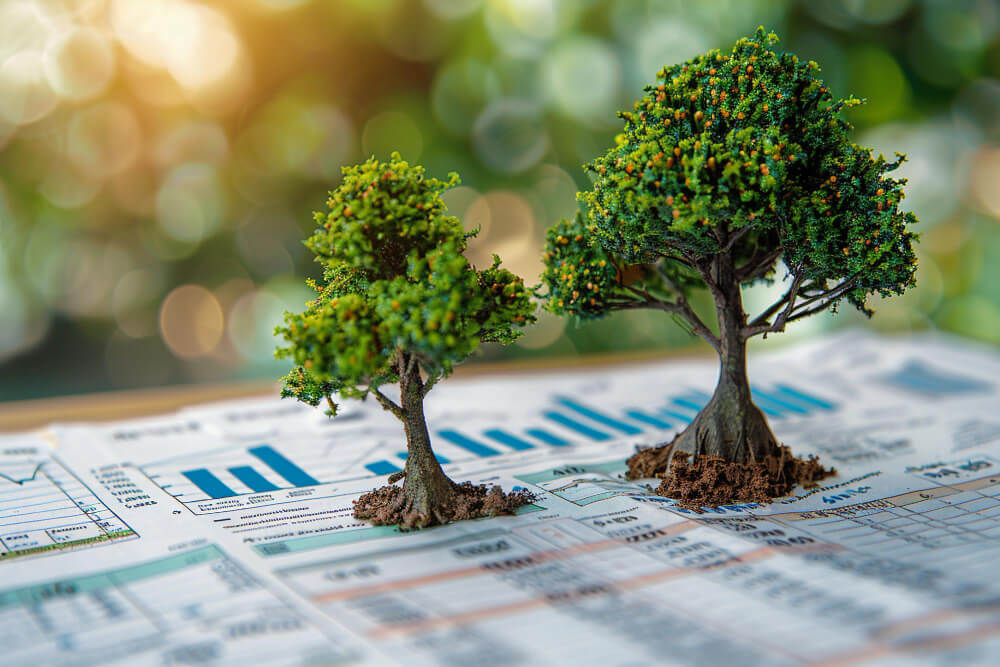
Sustainable investing is about aligning financial goals with environmental, social, and governance (ESG) issues. It’s about investing in businesses and assets that are not only self-sustaining but also helping to create a better world. As people become more aware of the global impact of their financial choices, this approach to investing is becoming more attractive. Sustainable portfolios ensure that your ideals align with your financial plans so that your investments promote responsible government and ethical behavior while ensuring growth.
The Importance of Value Fit and Returns
Building a sustainable portfolio starts with understanding your beliefs and how they translate into financial goals. Whether you’re focused on labor rights, business ethics, climate change, or sustainable energy, these principles can guide your investments. However, performance is crucial, which is another matter entirely. Not only should you invest responsibly, but you also want to ensure that your portfolio can provide good returns over the long term. Although data shows that well-constructed sustainable portfolios can perform as well as or better than traditional portfolios, many investors worry that sustainable investing may sacrifice profits for ethics.
Start with a Clear Goal
A good sustainable portfolio is built on clear goals. Ask yourself what you want your money to achieve. Are you looking for steady income, long-term expansion, or a mix of investments? Clarifying your financial goals will help you build a portfolio that fits them. Please also take your environmental goals into account. Do you want to support specific causes, avoid disruptive businesses, or invest in ESG leaders? These two goals will guide your investment choices and help you strike a balance between performance and value.
Choose the Right Investment Approach
There are many ways to invest sustainably; the best approach depends on your preferences and level of involvement. Some investors apply negative screening, in which they avoid industries such as guns, tobacco, or fossil fuels. Others focus on positive screening, looking for environmental leaders. You can also consider ESG integration, which is evaluating ESG factors against financial data to make investment choices. Impact investing—looking for investments with clear social or environmental benefits—is another option. All of these techniques can fit into a larger sustainable portfolio, depending on your priorities.
Diversify your Portfolio to Achieve Sustainable Development
Building a robust, sustainable portfolio relies on diversification, just like any other investment approach. To reduce risk, you should spread your money across multiple asset classes, industries, and regions. ESG-focused stocks, green bonds, sustainable mutual funds, and ETFs can all be included in a sustainable portfolio. You can also consider investing in companies with strong social goals, sustainable technologies, or green energy. Diversification can help you support a wide range of sustainable projects, so your investments align with your philosophy and protect your portfolio from volatility.
Apply Research Tools and ESG Ratings
If you want to create a sustainable portfolio that performs well, you need consistent data and research. Companies often use ESG ratings to assess their environmental, social, and governance performance. Agencies such as MSCI, Sustainalytics, and Morningstar provide these ratings. While these ratings are not perfect, they provide a useful basis for comparison between companies. In addition to ESG ratings, consider traditional financial metrics such as debt levels, earnings, and growth potential. Making informed decisions is the essence of sustainable investing, which requires both financial awareness and ethical research.
Avoid Misrepresentation and Greenwashing
Greenwashing—where a company or fund manufactures claims about its environmental or social practices—is one of the difficulties of sustainable investing. Building a truly sustainable portfolio requires insight into past marketing tactics and a deep understanding of the true behavior of the companies and funds you invest in. Review annual reports, check ESG disclosures, and consider third-party assessments. Look closely at how companies treat their employees, control pollutants, or operate. Responsible investors do their research and hold companies accountable.
Balancing Risk and Reward
Like all investments, sustainable investing involves risk. The trick is to balance your need for profit with your desire for impact. Some sectors that align with the SDGs, such as renewable energy or electric vehicles, can be volatile. Other sectors can offer additional stability; these can be ESG-focused bonds or funds. Building a portfolio that performs well over the long term depends on your risk appetite and investment horizon. Research, diversification, and ongoing monitoring can help you manage risk while supporting the goals you support.
Conclusion
Building a sustainable portfolio is not only feasible but also a smart and ethical way to grow your wealth. Sound financial analysis combined with ethical principles can help you design a portfolio that both generates returns and benefits the planet. The process starts with outlining your goals, researching options, and selecting investments that meet your financial and environmental criteria. Maintaining a successful portfolio requires ongoing monitoring, diversification, and avoiding greenwashing. Sustainable investing is a rewarding way to align your investments with your goals and create a better future with careful planning and the right tools.
FAQs
1. What is a sustainable investment portfolio?
A sustainable portfolio is a collection of choices based on their positive impact on social, environmental, or governmental issues, as well as financial returns.
2. Is sustainable investing profitable?
In fact, many sustainable investments perform as well as traditional investments, or even better. Good risk management and long-term stability often come with strict ESG criteria.
3. Where can I find sustainable investment options?
Look for stocks, ETFs, and mutual funds with a high ESG score. Many investment websites offer tools and filters to help you find environmentally friendly investment options.
4. Does it take a lot of money to start investing sustainably?
No, ESG-focused mutual funds or ETFs allow you to start with a small amount. Many websites allow beginners to invest sustainably.
5. How can I make sure my investments are truly sustainable?
Use ESG scores, annual reports, and external reviews for research. Prevent greenwashing by confirming a company’s actual environmental policies and commitments.
